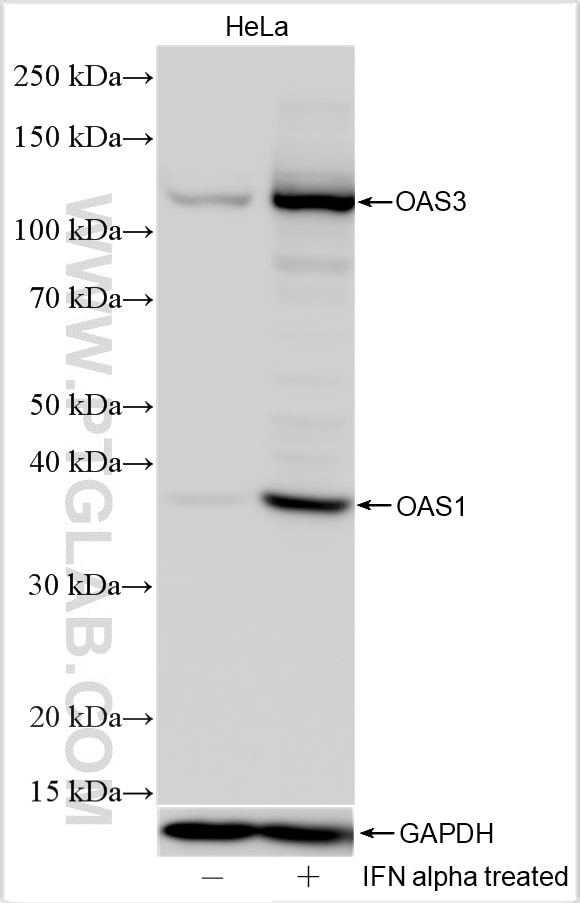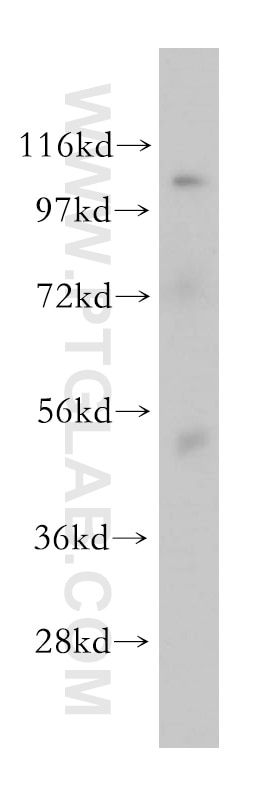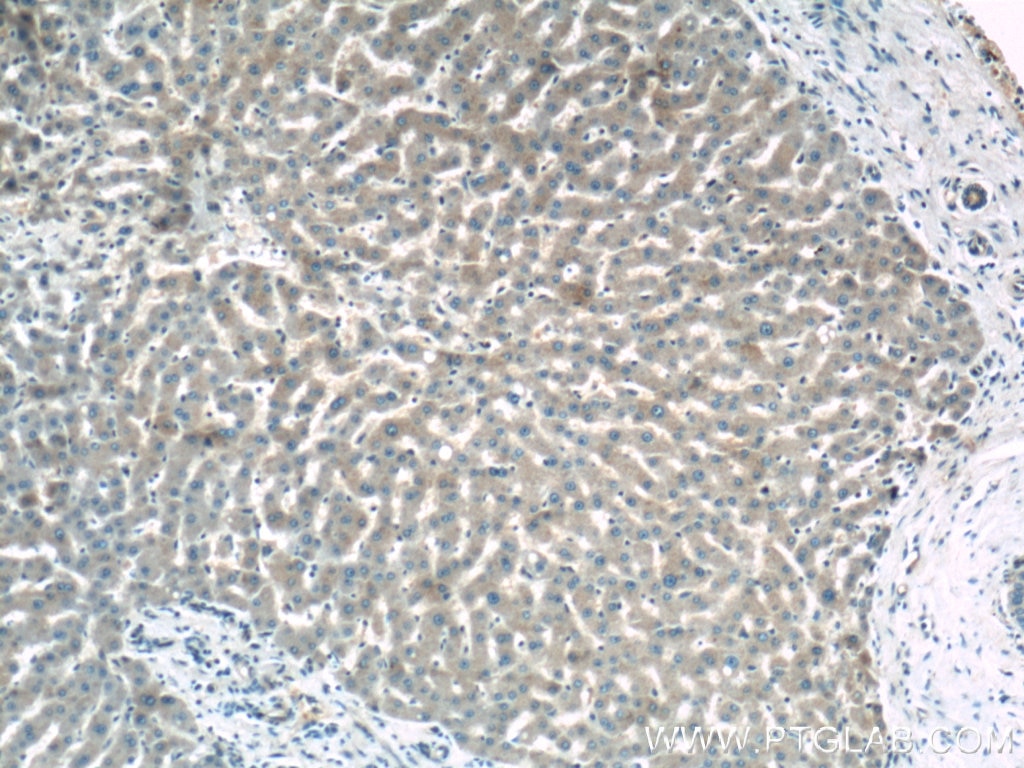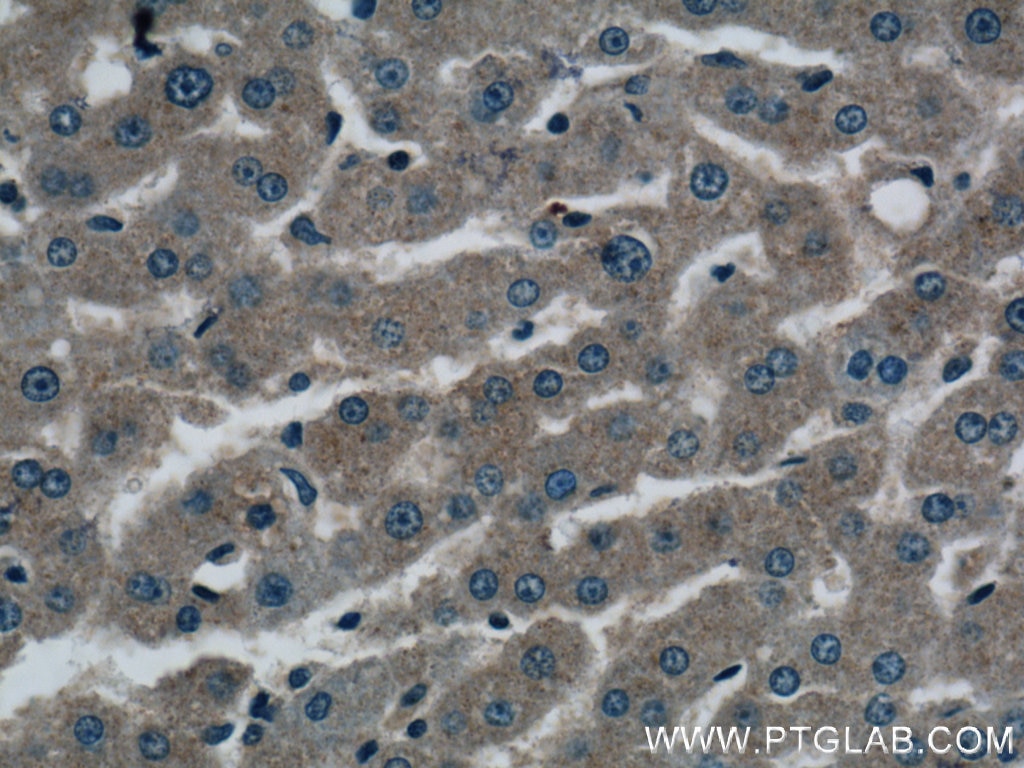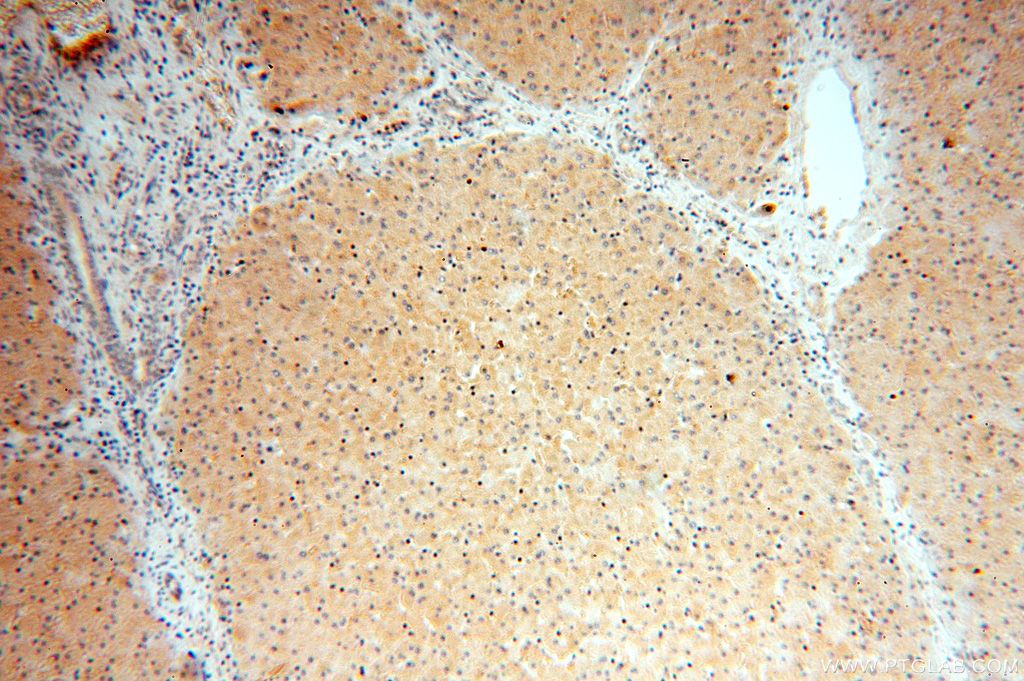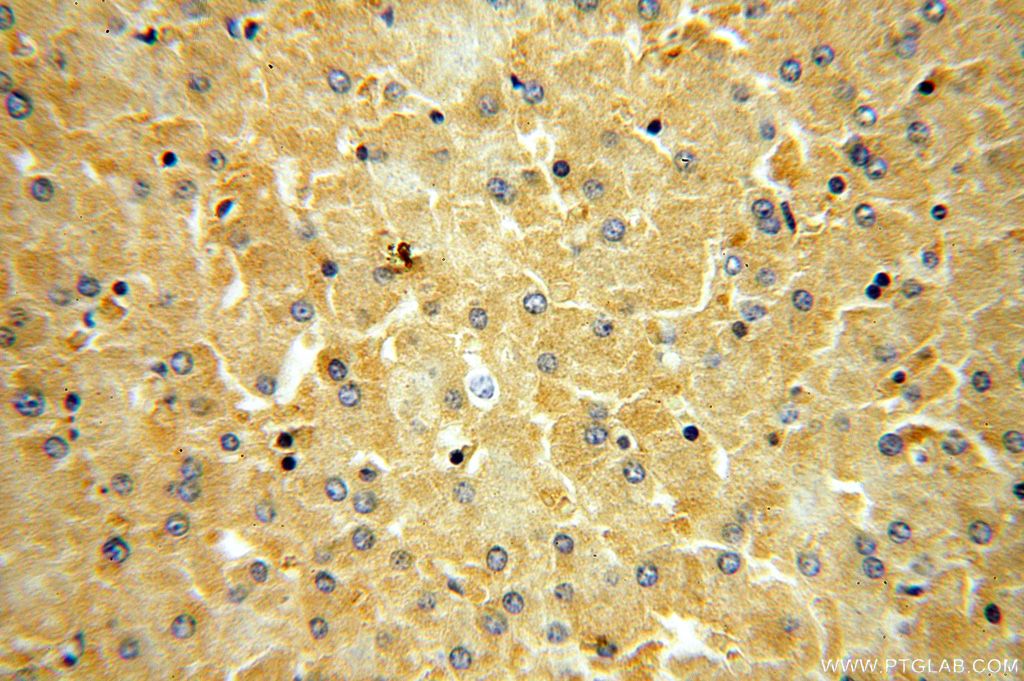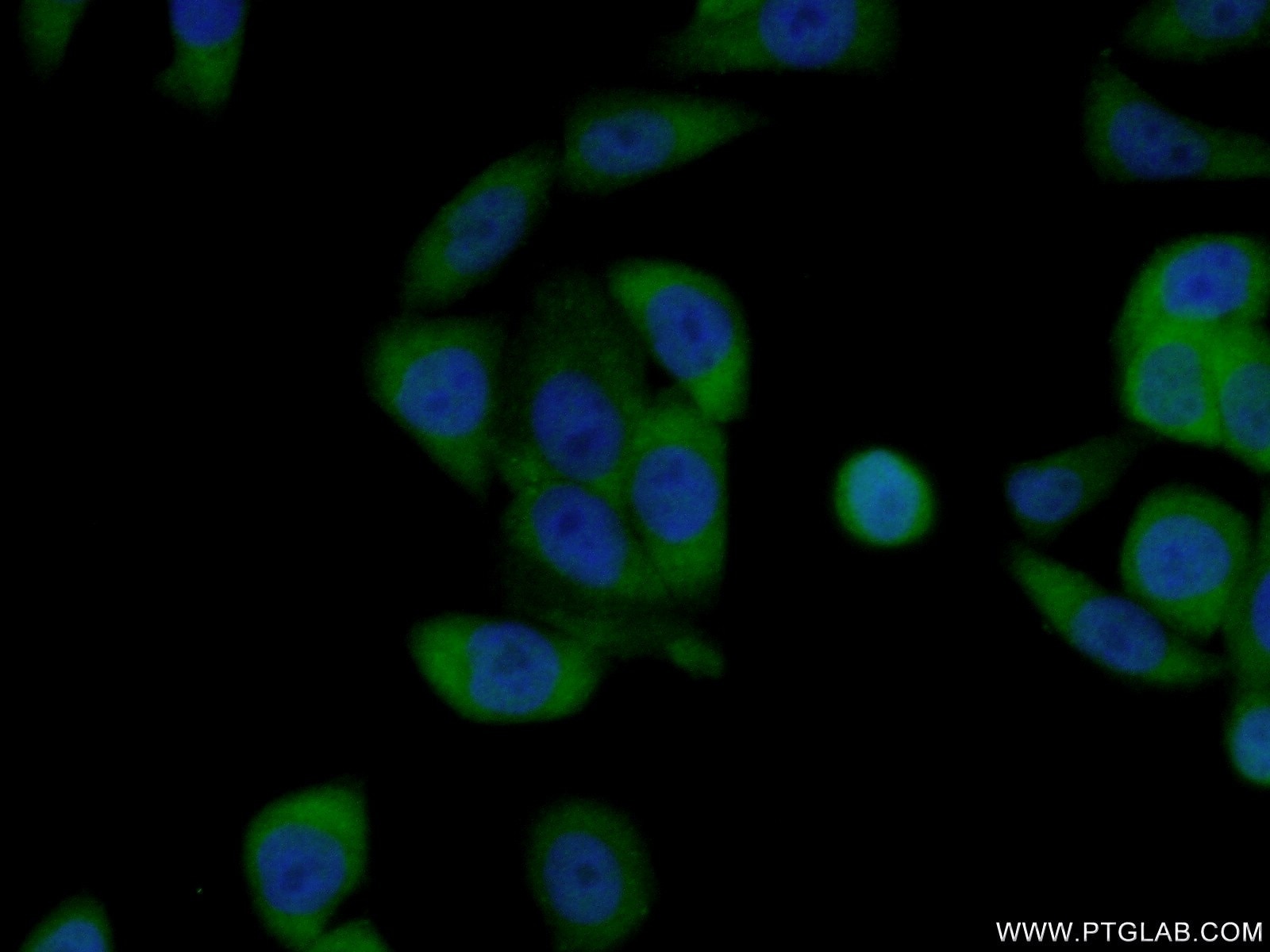- Phare
- Validé par KD/KO
Anticorps Polyclonal de lapin anti-OAS1/3
OAS1/3 Polyclonal Antibody for WB, IF, IHC, ELISA
Hôte / Isotype
Lapin / IgG
Réactivité testée
Humain, souris et plus (2)
Applications
WB, IHC, IF/ICC, CoIP, ELISA
Conjugaison
Non conjugué
N° de cat : 14955-1-AP
Synonymes
Galerie de données de validation
Applications testées
| Résultats positifs en WB | IFN alpha treated HeLa cells, tissu cérébral de souris |
| Résultats positifs en IHC | tissu hépatique humain il est suggéré de démasquer l'antigène avec un tampon de TE buffer pH 9.0; (*) À défaut, 'le démasquage de l'antigène peut être 'effectué avec un tampon citrate pH 6,0. |
| Résultats positifs en IF/ICC | cellules HeLa |
Dilution recommandée
| Application | Dilution |
|---|---|
| Western Blot (WB) | WB : 1:500-1:2000 |
| Immunohistochimie (IHC) | IHC : 1:100-1:400 |
| Immunofluorescence (IF)/ICC | IF/ICC : 1:50-1:500 |
| It is recommended that this reagent should be titrated in each testing system to obtain optimal results. | |
| Sample-dependent, check data in validation data gallery | |
Applications publiées
| KD/KO | See 2 publications below |
| WB | See 24 publications below |
| IHC | See 3 publications below |
| IF | See 2 publications below |
| CoIP | See 1 publications below |
Informations sur le produit
14955-1-AP cible OAS1/3 dans les applications de WB, IHC, IF/ICC, CoIP, ELISA et montre une réactivité avec des échantillons Humain, souris
| Réactivité | Humain, souris |
| Réactivité citée | rat, Humain, porc, souris |
| Hôte / Isotype | Lapin / IgG |
| Clonalité | Polyclonal |
| Type | Anticorps |
| Immunogène | OAS1/3 Protéine recombinante Ag6793 |
| Nom complet | 2',5'-oligoadenylate synthetase 1, 40/46kDa |
| Masse moléculaire calculée | 46 kDa |
| Poids moléculaire observé | ~40 kDa, 100-120 kDa |
| Numéro d’acquisition GenBank | BC000562 |
| Symbole du gène | OAS1 |
| Identification du gène (NCBI) | 4938 |
| Conjugaison | Non conjugué |
| Forme | Liquide |
| Méthode de purification | Purification par affinité contre l'antigène |
| Tampon de stockage | PBS avec azoture de sodium à 0,02 % et glycérol à 50 % pH 7,3 |
| Conditions de stockage | Stocker à -20°C. Stable pendant un an après l'expédition. L'aliquotage n'est pas nécessaire pour le stockage à -20oC Les 20ul contiennent 0,1% de BSA. |
Informations générales
The 2-prime,5-prime oligoadenylate synthetases (OASs), such as OAS1, are interferon-induced proteins characterized by their capacity to catalyze the synthesis of 2-prime,5-prime oligomers of adenosine (2-5As). OAS1 (type I enzymes) has some isoforms with the MW of 40, 42, 44, 46, and 48 kDa (PMID:12590567, 19383565). OAS1 is a strong candidate for determining susceptibility or resistance to viral infections(PMID:15732009). This antibody may have cross-reaction with OAS3 protein due to the high homology.
Protocole
| Product Specific Protocols | |
|---|---|
| WB protocol for OAS1/3 antibody 14955-1-AP | Download protocol |
| IHC protocol for OAS1/3 antibody 14955-1-AP | Download protocol |
| IF protocol for OAS1/3 antibody 14955-1-AP | Download protocol |
| Standard Protocols | |
|---|---|
| Click here to view our Standard Protocols |
Publications
| Species | Application | Title |
|---|---|---|
Nat Cell Biol Redox regulation of m6A methyltransferase METTL3 in β-cells controls the innate immune response in type 1 diabetes | ||
Adv Sci (Weinh) The CRISPR-Cas13a Gene-Editing System Induces Collateral Cleavage of RNA in Glioma Cells. | ||
PLoS Biol Resurrection of 2'-5'-oligoadenylate synthetase 1 (OAS1) from the ancestor of modern horseshoe bats blocks SARS-CoV-2 replication | ||
Autophagy USP19 (ubiquitin specific peptidase 19) promotes TBK1 (TANK-binding kinase 1) degradation via chaperone-mediated autophagy. | ||
J Invest Dermatol OAS1, OAS2, and OAS3 Contribute to Epidermal Keratinocyte Proliferation by Regulating Cell Cycle and Augment Type I Interferon-Induced JAK1-STAT1 Phosphorylation in Psoriasis.
|
Avis
The reviews below have been submitted by verified Proteintech customers who received an incentive forproviding their feedback.
FH Seong (Verified Customer) (11-27-2018) | OAS1 polyclonal antibody (14955-1-AP) did work by Western Blot (1:1,500) of ARPE-19 cells induced with interferon gamma but the band was very weak in uninduced cells.
|
